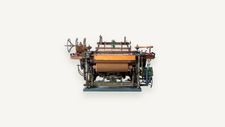
Tough Fabrics
Following the Second World War, the clothing and textile industry flourished in North Rhine-Westphalia. The sector had a tradition of high quality wares from the Münsterland to the Lower Rhine. But crisis loomed by the end of the 1960s as cheaply produced items from abroad flooded the market, and demand was on the decline. Many textile businesses were forced to close.
However, weaving looms by the firm C. A. Roscher, such as this, outlived the crisis and remained in constant use. While businesses had to react to changes in the market and continually adjust their production, the loom stayed in service from its acquisition in the 1920s all the way through the 1980s. This was because weavers knew how to operate it. It was technically straightforward, could be combined with other looms of the same design and was able to keep up with the latest trends with the help of technical upgrades. Furthermore, businesses were reluctant to replace entire arrays of machines. The weavers’ long experience with the old looms was frequently more valuable than a costly retrofit with new machines.
Businesses survived by specialising. They found niches; for instance, the company Ibena in Rhede produced high-tech textiles for fire and police uniforms, work clothing and racing wear. Formula 1 world champion Kimi Räikkönen, for example, drives in a fireproof suit made of Ibena material. You can find one of his suits in a display case on your way to the next exhibition area.